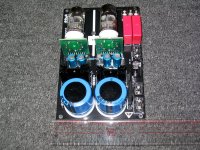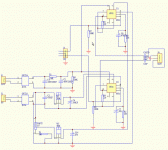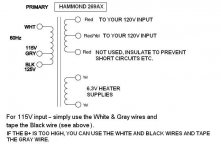As you might have guessed ,I'm new to tube circuits. I purchased a few pre built tube preamp boards for use as a gain stage in resistor i/v on some TDA1541 cd players I have. The boards are straight forward , with very easy hook-up. 120vac , 6.3vac , input , output. Bridge diodes are included onboard for each power supply. I'm currnetly using Line voltage 120vac and a 6.3vac transformer for heaters. The circuits works fine. In my shop , I use a 2 channel reciever for testing. Everything worked fine, sounded very good , and I was quite proud of myself😉. HOWEVER , I brought the player into my house and connected to my main system. This includes a good quality tube pre amp , that I have owned for 15yrs without issue. When I connected it to my tube pre , upon turning it 'on' , the player blow a fuse. i figured it was a glitch, so I replaced the fuse with a slow blow type. This also blew. Took it back to the shop , connected it to my reciever and NO problems, players fine. Back to the house , fuse blows. Anyone have insight? Pics below
Attachments
Indeed. I have a large 100W amp in my basement that works this way. I have never plugged it in for this reason. Get a transformer!
The problem is simple. You must isolate the 120 V input with a transformer.
I see. How does the direct connection cause a problem when connected to some components and not others? It does not 'appear' to be a problem with SS pre amps , only on the 2 TUBE pre amps I have tried.
So I need a 120v-120v trans?
Thanks
You are tying the circuit to your home's mains. Depending which way you wired the hot and the neutral to the circuit, one of them becomes the common in the amp. If you then plug that into a component that ties its signal common to earth ground, you have just shorted that leg of your home's wiring to earth ground. In your case, it sounds like you have the hot side appearing as the common. You have been lucky that you have not been shocked.
It's possible that either the outlet in your shop or your home has the hot and neutral reversed, which is perhaps why you didn't receive a shock while in the shop.
It's possible that either the outlet in your shop or your home has the hot and neutral reversed, which is perhaps why you didn't receive a shock while in the shop.
You are tying the circuit to your home's mains. Depending which way you wired the hot and the neutral to the circuit, one of them becomes the common in the amp. If you then plug that into a component that ties its signal common to earth ground, you have just shorted that leg of your home's wiring to earth ground. In your case, it sounds like you have the hot side appearing as the common. You have been lucky that you have not been shocked.
It's possible that either the outlet in your shop or your home has the hot and neutral reversed, which is perhaps why you didn't receive a shock while in the shop.
OK. It makes sense now. I did measure for voltage on the rca's ground side and it was 0v(line hot or neutral to output ground). Not that I'm trying to explain away the issue , but if the tube circuit is isolated from the chassis and the rca's are also , does this make any difference?
I see. How does the direct connection cause a problem when connected to some components and not others? It does not 'appear' to be a problem with SS pre amps , only on the 2 TUBE pre amps I have tried.
So I need a 120v-120v trans?
Thanks
When you use a bridge rectifier directly from the wall (you're looking to die - SOON), in essence your output negative ('ground') is connected to both sides of the AC line. It isn't really, just every other half cycle.
DO NOT SCREW AROUND WITH DIRECT CONNECTED SUPPLIES !!! (until you know exactly WHAT you're doing)
If you're not having trouble connecting to some units it because THOSE transformers are covering your butt. It you touch your 'ground' and a true earth ground, you will get a nasty potentially lethal shock.
If I seem harsh, it's to keep you around. Always always ALWAYS use a transformer for your projects and experiments.
G²
When you use a bridge rectifier directly from the wall (you're looking to die - SOON), in essence your output negative ('ground') is connected to both sides of the AC line. It isn't really, just every other half cycle.
DO NOT SCREW AROUND WITH DIRECT CONNECTED SUPPLIES !!! (until you know exactly WHAT you're doing)
If you're not having trouble connecting to some units it because THOSE transformers are covering your butt. It you touch your 'ground' and a true earth ground, you will get a nasty potentially lethal shock.
If I seem harsh, it's to keep you around. Always always ALWAYS use a transformer for your projects and experiments.
G²
I do appreciate this. I'm very glad I looked to this forum
Last edited:
I would add at least two or three more ALWAYS's.
In the old days they had electronic stuff that wasn't isolated. They solved it by putting the gear into plastic cabinets, insulating knobs, and kept the chassis covered. If there was need for an external connection, they isolated it with a capacitor but there were lots of hum problems.
I had a cute one tube radio as a kid. It almost killed me a number of times.
In the old days they had electronic stuff that wasn't isolated. They solved it by putting the gear into plastic cabinets, insulating knobs, and kept the chassis covered. If there was need for an external connection, they isolated it with a capacitor but there were lots of hum problems.
I had a cute one tube radio as a kid. It almost killed me a number of times.
It appears I was mislead by the seller , but I suppose I should have known better. What usually makes sense, should be obvious. Please see pic below.
Can anyone suggest a good transformer for this circuit? Maybe a link?
Thank you all for saving my butt.
Paul
Can anyone suggest a good transformer for this circuit? Maybe a link?
Thank you all for saving my butt.
Paul
Attachments
Hi Paul, you need something like a Hammond 269AX or similar. A transformer with 115V input and giving two outputs. One output will be 115V to make the B+ supply for the amplifier and also provide 6V for the Tube Heater supply.
The 269AX has a 250V output but also has a centre tap (Red/Yellow wire) so by using this, the output will be 125V when used in conjunction with either of the Red wires as shown on the circuit. Just tape up the unused Red wire so it cannot short anywhere. If you think the 125V may be a little high then you can use the additional winding on the primary (i.e. connect your main supply to Black and Gray) and this will have the effect of giving you 115V input to your amp using the fore-mentioned Red and Red/Yellow wires. Don't forget to tape up the unused primary wire whether it is the Black or Gray one.
It goes without saying really that the reason why some amplifier kits and projects are sold at seemingly bargain prices is because the seller conveniently leaves out the most expensive items and of course makes no mention of the fact that you need to buy this as an extra 🙁.
Les
The 269AX has a 250V output but also has a centre tap (Red/Yellow wire) so by using this, the output will be 125V when used in conjunction with either of the Red wires as shown on the circuit. Just tape up the unused Red wire so it cannot short anywhere. If you think the 125V may be a little high then you can use the additional winding on the primary (i.e. connect your main supply to Black and Gray) and this will have the effect of giving you 115V input to your amp using the fore-mentioned Red and Red/Yellow wires. Don't forget to tape up the unused primary wire whether it is the Black or Gray one.
It goes without saying really that the reason why some amplifier kits and projects are sold at seemingly bargain prices is because the seller conveniently leaves out the most expensive items and of course makes no mention of the fact that you need to buy this as an extra 🙁.
Les
Attachments
where did you get those?
Homemade
Would you post the information on the source for the boards you bought?
Cost, vendor ect.
Thanks
Homemade
Would you post the information on the source for the boards you bought?
Cost, vendor ect.
Thanks
I see. How does the direct connection cause a problem when connected to some components and not others? It does not 'appear' to be a problem with SS pre amps , only on the 2 TUBE pre amps I have tried.
So I need a 120v-120v trans?
Thanks
Yes!!!! This is absolutely lethal - it is a wonder that you did not electrocute yourself, blow up your amp, or start a fire - all possible consequences of running transformerless. Also the fact that fuse blows in one location and not the other is probably an indication that one of those outlets may be wired backwards. Get an outlet checker and make sure they are all wired correctly.
It appears I was mislead by the seller , but I suppose I should have known better. What usually makes sense, should be obvious. Please see pic below.
Indeed, that is very misleading for someone not familiar with these things.
Homemade
Would you post the information on the source for the boards you bought?
Cost, vendor ect.
Thanks
Ebay item
STEREO 6DJ8 ECC88 6922 E88CC SRPP TUBE PREAMPLIFIER KIT - eBay (item 350190462704 end time Apr-09-10 08:30:30 PDT)
Anyone have a good link to a cheap transformer for this pre amp board?
I appreciate everyones safety concerns
He lists one right in the auction:
0 - 110V + 0 - 9V 50VA TUBE AMP POWER TRANSFORMER! - eBay (item 380216709359 end time Apr-17-10 20:49:12 PDT)
0 - 110V + 0 - 9V 50VA TUBE AMP POWER TRANSFORMER! - eBay (item 380216709359 end time Apr-17-10 20:49:12 PDT)
He lists one right in the auction:
0 - 110V + 0 - 9V 50VA TUBE AMP POWER TRANSFORMER! - eBay (item 380216709359 end time Apr-17-10 20:49:12 PDT)
Yes , but with shipping it's over $50. At least to the US
Something like this should suffice.
VPT230-110 Triad Magnetics Transformers
You can also search for surplus line isolation transformers elsewhere.
VPT230-110 Triad Magnetics Transformers
You can also search for surplus line isolation transformers elsewhere.
- Status
- Not open for further replies.
- Home
- Amplifiers
- Tubes / Valves
- Why am I blowing fuses when connecting to next component?



